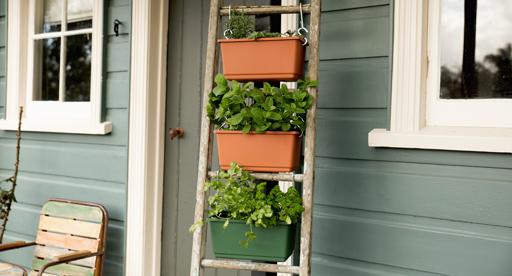
Fragrant herbs will add a flavour punch to any meal, particularly when they are freshly snipped from your own garden.
Create a herb ladder by filling containers with a variety of tasty herbs, and you’ll be harvesting a bumper crop of homegrown herbs this season.
Prepare
1. Select containers you can attach to the ladder. Plastic containers are a good option.
2. Drill holes in the bottom of the containers for drainage.
Plant
3. Select a variety of herbs. The best times to plant are early in the morning or late in the day, so the plants aren’t exposed to the hot sun straight away. Don’t be shy when planting herbs as they quite like close neighbours. You can either plant each container with one kind of herb, or mix a variety of herbs together. If you are mixing different types together, ensure they like the same conditions – e.g. rosemary likes drier conditions, whereas basil will need more regular watering. We planted mint in one container; coriander and parsley in the second; and rosemary, oregano and purple sage in the third.
4. Before planting your herb plants, soak them in a bucket of Tui Organic Seaweed Plant Tonic and allow to drain. This will help prevent transplant shock.
5. Partly fill your container with Tui Herb Mix, a free draining planting mix, rich in nitrogen to promote green, leafy growth and continuous harvesting. Tui Herb Mix also contains SaturAid soil wetter, which spread water evenly to the root zone and encourage rapid root development while preventing soil from becoming waterlogged.
6. Tap the container gently on the ground to settle the mix.
7. Gently loosen the root ball of your plant and position the plant in the container. Ensure the plant is sitting at the same level in the soil as it was in its seedling container.
8. Repeat with the remaining herbs.
9. Fill in with Tui Herb Mix, up to 3cm from the top.
10. Press soil gently around the base of the plant.
11. Water your herbs well.
12. Hang the planted herb containers on the ladder using S Hooks/Butcher's Hooks.
13. Place the ladder near your kitchen if possible, so it is easy to access and snip some fresh herbs when cooking!
Nourish
14. Feed your herbs and they will feed you. Plants use nutrients from the soil as they grow, so replenishing nutrients used by your herbs ensures they will grow to their full potential. Use Tui NovaTec Premium fertiliser to feed your herbs. Well watered, well nourished herbs will have a better chance of keeping insect pests and diseases at bay.
Herbs aren’t generally affected by pests and diseases, although if your herbs are indoors, lack of sunlight and airflow can reduce plant vigour and attract insect pests like whitefly. To combat, move your herbs outside when you can, and if you get an infestation treat with a suitable insect spray.
Top Tips
- If you want to try something different, plant a combination of Vietnamese mint, Thai basil and lemongrass – all wonderful additions to Asian cooking.
- Over summer some herbs like coriander, parsley and basil are prone to go to seed. To avoid, water your herbs consistently, regularly pick,remove flowers and remove parts of the plant that go to seed. If your herbs do go to seed there is an upside – the flowers are great for beneficial insects like bees, and if you let them fully dry out you can collect the seeds for next season!
- Pick fresh herbs and add to your salad or stir-fry.
- If you have an excess of herbs, chop them up and freeze them in ice cubes – these can then be used in drinks and meals later in the year. Mint is especially good for this.
- Jan
- Feb
- Mar
- Apr
- May
- Jun
- Jul
- Aug
- Sep
- Oct
- Nov
- Dec
- Harvest in 30-45 days
Shopping list
- Tui Herb Mix
- Tui Organic Seaweed Plant Tonic
- Tui NovaTec Premium fertiliser
- Debco SaturAid
- herb seedlings, containers, ladder, hooks to hang containers on ladder.
Post a comment
Herb Ladder Guide Comments
What a great idea. Would love to try it in the future.
Jim